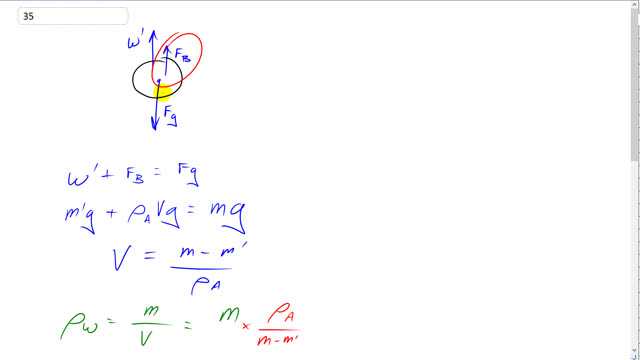
A 0.48-kg piece of wood floats in water but is found to sink in alcohol (SG = 0.79), in which it has an apparent mass of 0.047 kg. What is the SG of the wood?

In order to watch this solution you need to have a subscription.
This is Giancoli Answers with Mr. Dychko. When this wood is submerged in alcohol, there's gonna be a buoyancy force upwards due to the weight of the alcohol and then there's gonna be gravity downwards and then also this apparent weight upwards this spring scale force upwards, W prime. And so W prime plus buoyancy force in total equals the gravity down and that's the apparent mass times g plus the volume of the alcohol displaced which is the volume of the wood times by the density of the alcohol and that gives the total mass of alcohol displaced times g gives weight of the alcohol displaced which is the buoyancy force according to Archimedes principle and that equals mg, the weight of the thing, true mass times g. So we can rearrange this to solve for the volume and that's useful because we can then find the density of the wood is the mass divided by this volume. We'll take this m prime to the right hand side by subtracting it from both sides and then divide by density of alcohol; we have the volume then is true mass minus apparent mass divided by density of alcohol. So then looking at the density of wood, it's the mass divided by volume and then that's gonna be mass divided by this fraction but instead of dividing by the fraction, we'll multiply by its reciprocal so we have true mass multiplied by density of alcohol divided by true mass minus apparent mass— and just rewrote it there more nicely— and then what we have to actually find though is specific gravity not the density of the wood but specific gravity is the density divided by the density of water. So let's divide both sides of this equation by density of water... I mean we can divide both sides by whatever we like and so let's choose to make it density of water that we are dividing by in which case this left hand side becomes specific gravity of wood. And then on the right hand side, we have density of alcohol divided by density of water which is the specific gravity of the alcohol and we are given this specific gravity of alcohol—0.79— and we multiply that by the 0.48 kilograms— true mass of this wood— divided by 0.48 minus 0.047 kilograms and that gives 0.88 is the specific gravity of the wood.